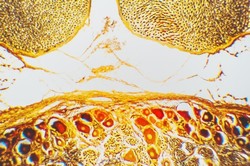Export of large cargo from the cell
The conventional coat protein complex II (COPII)-coated vesicles transport secreted proteins through the endoplasmic reticulum (ER)/Golgi pathway and have a diameter of 60-90 nm. Human cells express 28 different collagens containing rigid triple helical domains of 450 nm in length. Besides collagen, other secreted molecules like chylomicrons and very low density lipoproteins (VLDLs) are too large to fit into COPII-coated vesicles. The EU-funded CUPS (Reconstitution of CUPS in vitro and assessing the mechanism of their cargo packing during unconventional protein secretion) ended up with studies on the molecular mechanism underlying the secretion of large cargos from mammalian cells. Previous studies discovered that one of the transport and Golgi organisation (TANGO) proteins, the TANGO1 protein, is a key player in the export of bulky procollagen from the ER. It is localised to ER exit sites and membrane fusion is also required for TANGO1-dependent export of procollagen. During the CUPS project, researchers untangled the whole complex of proteins required for the export of bulky cargo. Along with TANGO1, several membrane fusion proteins, the so-called SNARE proteins – Syntaxin 18, BNIP1, USE1, and YKT6, were found to be necessary for the formation of the export mega-carrier. TANGO1 recruits YKT6-containing ER Golgi intermediate compartment (ERGIC) membrane vesicles to procollagen-enriched patches on the ER. Thus, TANGO1 is pivotal in concentrating bulky cargo in the lumen and recruiting ERGIC membrane vesicles on the cytoplasmic surface of the ER. These data demonstrated that growth of a mega-carrier vesicle for collagen export from the ER happens by addition of ERGIC membranes to cargo-enriched domains of the ER by a TANGO1-mediated process. The last part of the project was dedicated to investigating the export of other bulky particles from the ER, like chylomicrons and VLDLs, as their increased circulation is linked to the development of atherosclerotic plaques. The data showed that loss of TANGO1 or its homolog TALI reduced secretion of chylomicrons and VLDLs and associated secretion of apolipoprotein B. TANGO1 and TALI interact with apolipoprotein B to recruit bulky lipid particles to ER exit sites. Loss of TANGO1 or TALI leads to an accumulation of chylomicrons/VLDLs in the ER with possible consequences to the development of atherosclerosis.







